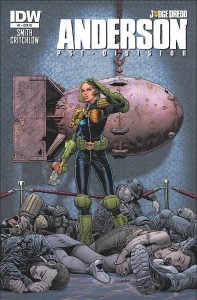
Written by Matt Smith
Art by Carl Critchlow
Published by IDW
In her solo debut for IDW, writer Matt Smith takes psychic judge Cassandra Anderson out of familiar territory to catch some robbers that have taken an old map of the Cursed Earth from a museum in Mega City One and most definitely have some kind of powers. Because she has no memories of life before she was a cadet in the Justice Department, her friends and colleagues have become her family. Going away from Mega City One to chase after thieves in the Alabama Morass with another psychic judge from Texas City breaks down Anderson to her core as a character while also telling a fast-paced action mystery story. Artist Carl Critchlow takes the action scenes out of panel boundaries and uses small reaction panels to provide insights into Anderson and the perps she is fighting. Even though his layouts aren’t particularly inventive (especially during the mind reading scene), Critchlow’s storytelling is clean and easy to follow. He draws Anderson’s body movements as relaxed and casual which complements her sarcasm and breezy attitude in Smith’s dialogue. This first issue is packed with exposition, especially concerning Anderson’s new partner DeGroot’s “psychogeography” power, but Smith uses the action in the Cursed Earth exhibit of the museum as an interesting enough hook to set up the miniseries.
Throughout Anderson #1, Smith and Critchlow make sure that readers understand that Anderson isn’t a female Judge Dredd with superpowers. She has much more of a sense of humor and actually thinks before killing a criminal. However, Anderson is no slouch when it comes to fighting crime and uses her powers to her advantage, like finding out a dead perp’s destination from latent psychic residue. Smith also explores the negatives of Anderson’s psychic powers in the opening of the comics where she senses the museum being robbed and talks about how sleep is the only time she has rest from the “creeps” whose minds she has to read all day and night. Critchlow’s depiction of Anderson’s apartment shows that she is dedicated to her job, but knows when to relax. Her room decor is minimal and centered around her work as a Judge, but there are some personal touches, like paintings and window treatments. These bursts of characterizations show how likable Anderson is as a character with her light, humorous exterior and sad, mysterious inner life.
Anderson #1 is an accessible introduction to Cassandra Anderson for new fans, or others that are familiar with her from Olivia Thirlby’s portrayal of her in the film Dredd. Smith gives Anderson the right amount of inner monologue to show that she is an introspective character, but also cares about others as shown by her friendly relationship with her superior, Judge Omar, and her interactions with DeGroot and the irate museum curator. Unfortunately, Smith decides to explain DeGroot’s psychogeographic powers through a long block of text instead of letting Critchlow show it visually. This power does work nicely with the theft of the map of the Cursed Earth from the museum, and Critchlow trades the crowded city blocks of Mega City One for the swamps and critters of the Alabama Morass. Despite some minor problems with the art and overreliance on exposition, Anderson #1 is an entertaining read with a unique setting, good combination of action and mystery, and a protagonist that shows that dystopias aren’t all gloom and doom.

